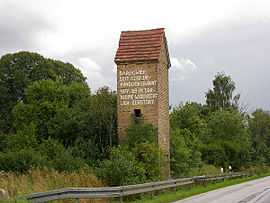Bardowiek
| Bardowiek | |
|---|---|
| Deserted village of Selmsdorf | |
 Bardowiek | |
| Coordinates: 53°52′N 10°50′E / 53.867°N 10.833°ECoordinates: 53°52′N 10°50′E / 53.867°N 10.833°E | |
| Country | Germany |
| State | Mecklenburg-Vorpommern |
| District | Nordwestmecklenburg |
| Municipality | Selmsdorf |
| Population | |
| • Total | 0 |
| Time zone | CET/CEST (UTC+1/+2) |
Bardowiek is a ghost town in Germany.
History
The earliest surviving record of Bardowiek’s is in the Ratzeburger Hufenregister and dates from 1292. The town was virtually destroyed during the Thirty Years War, but was rebuilt after the war’s end in 1648.

During the early years of the German Democratic Republic there were still approximately forty residents. However, Bardowiek found itself in the five kilometre wide closed zone, a strip of land cleared by the government directly to the east of the Inner German border. In 1960 all the farmsteads were incorporated into the farming collective of Palingen. Destruction of the former farms began in 1977 and was completed only in 1989. After the reunification surviving former residents sought to rebuild the village. However, their aspirations have been thwarted by a succession of legal disputes.[1]
Context of Bardowiek's destruction
In the district of North-west Mecklenburg alone, no fewer than thirteen separate villages were destroyed during the later decades of the East German state in order to clear a strip of land beside the Inner German border. This was done to create a larger territory of a "no-go area" closest to the border to West Germany after the east became concerned about the extent of emigration to the western state. Other nearby destroyed villages included Lenschow, Wahlstorf (Lüdersdorf), Lankow (Mustin) and Neuhof (Gadebusch).